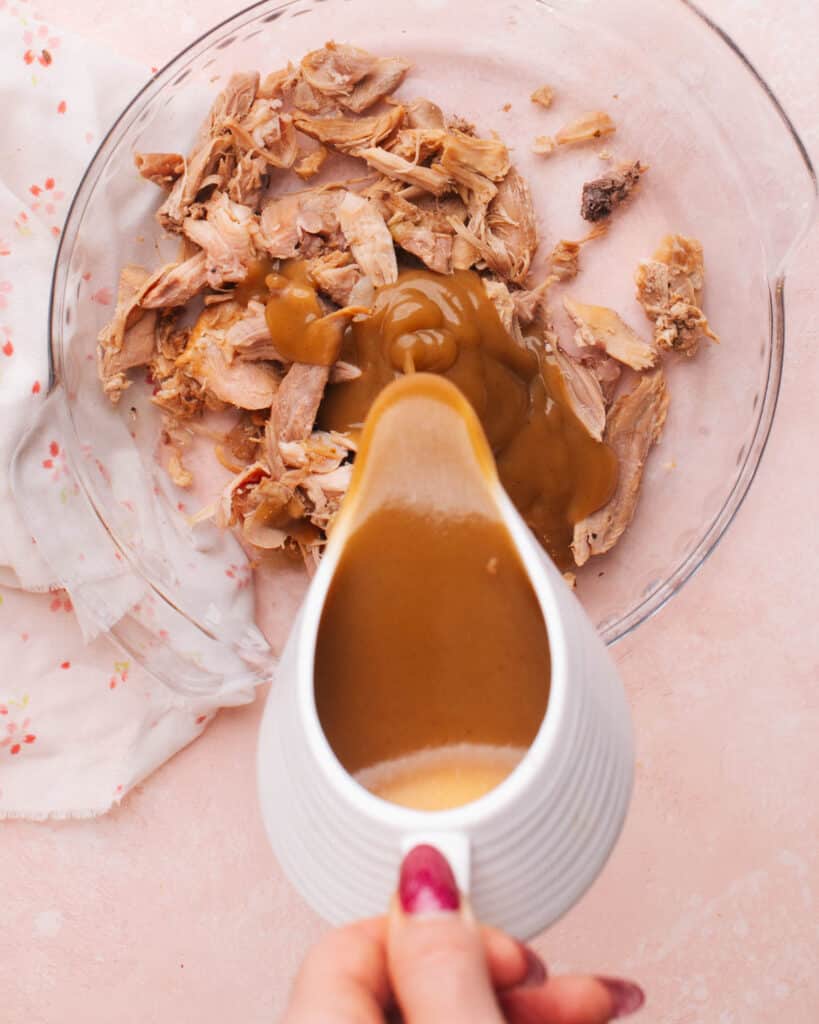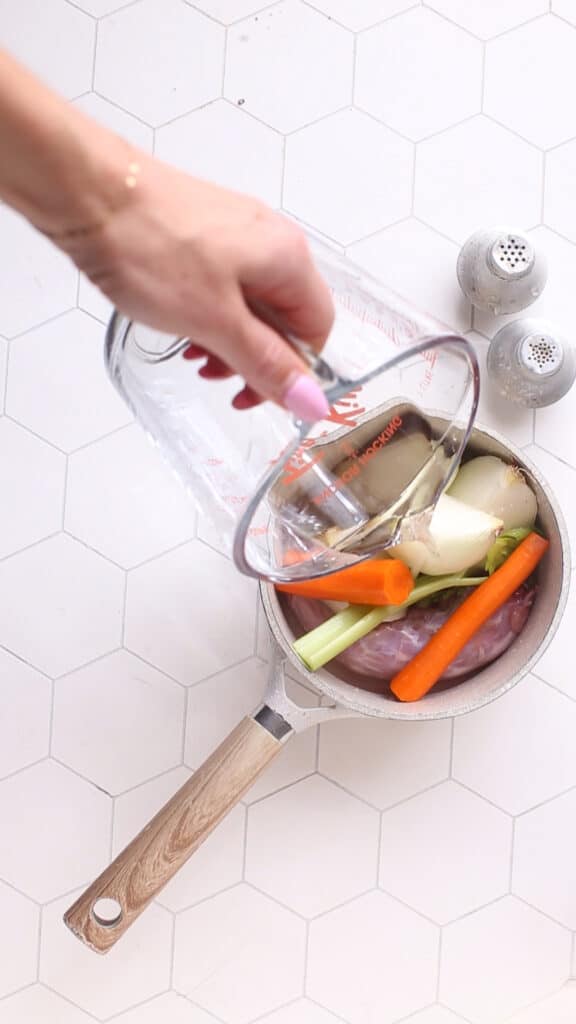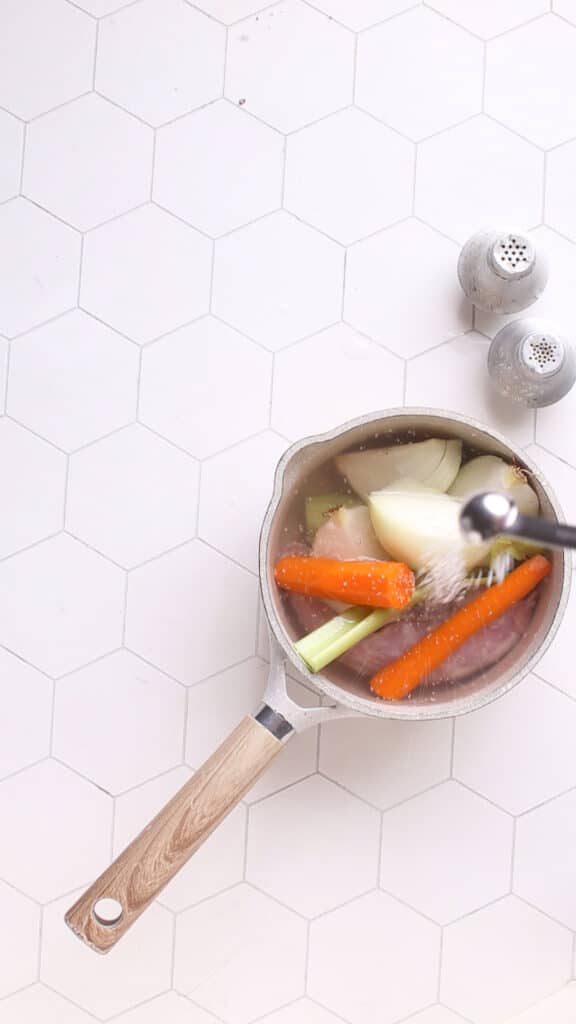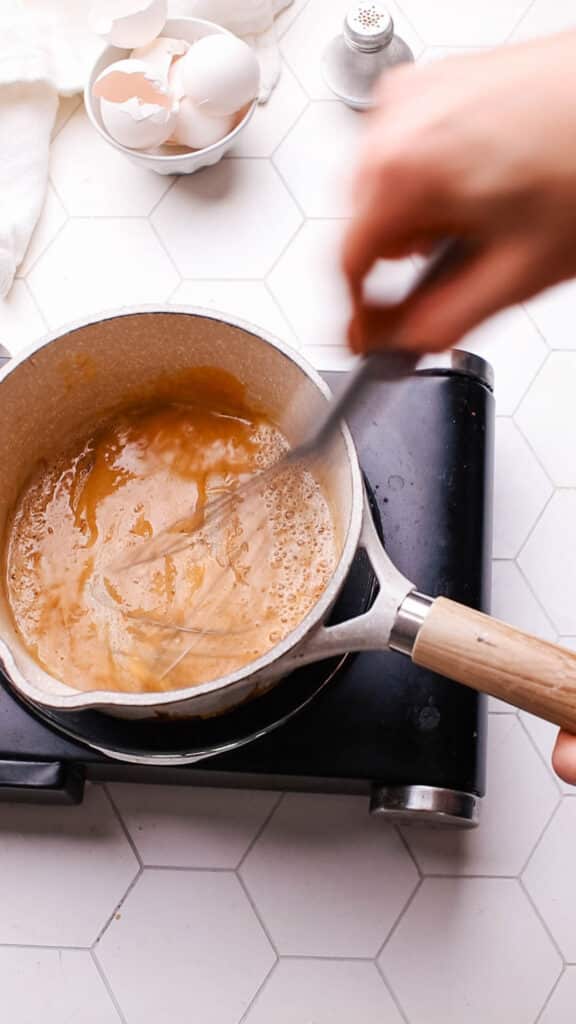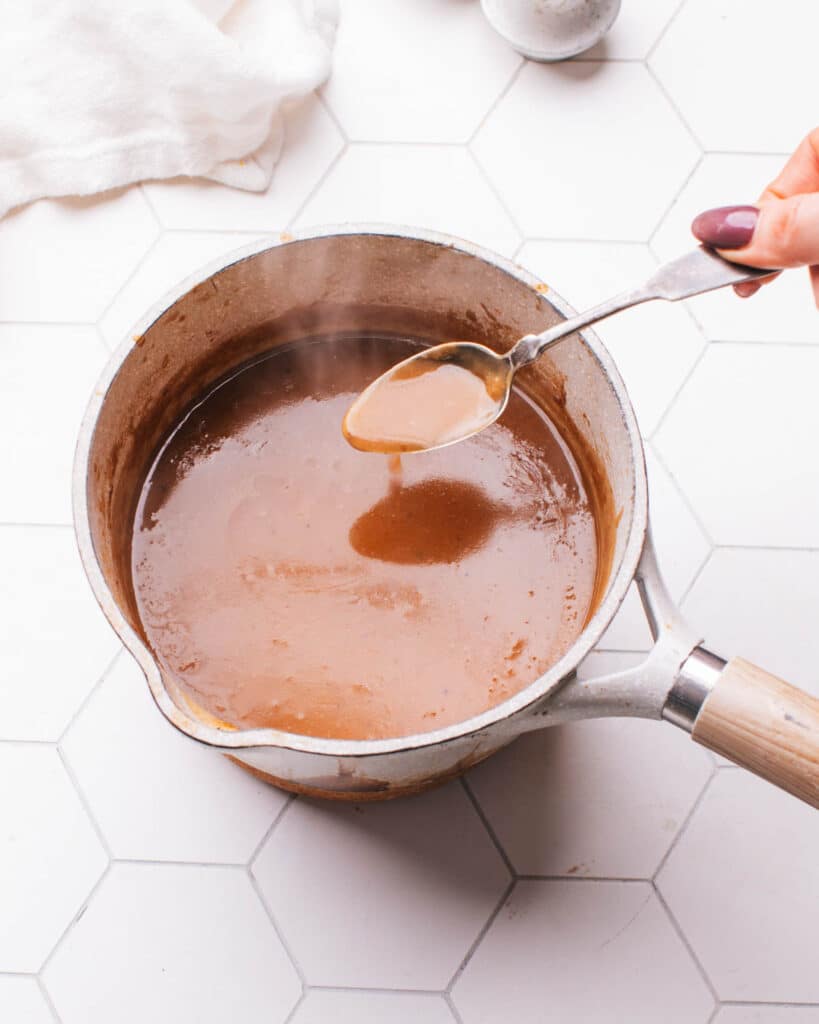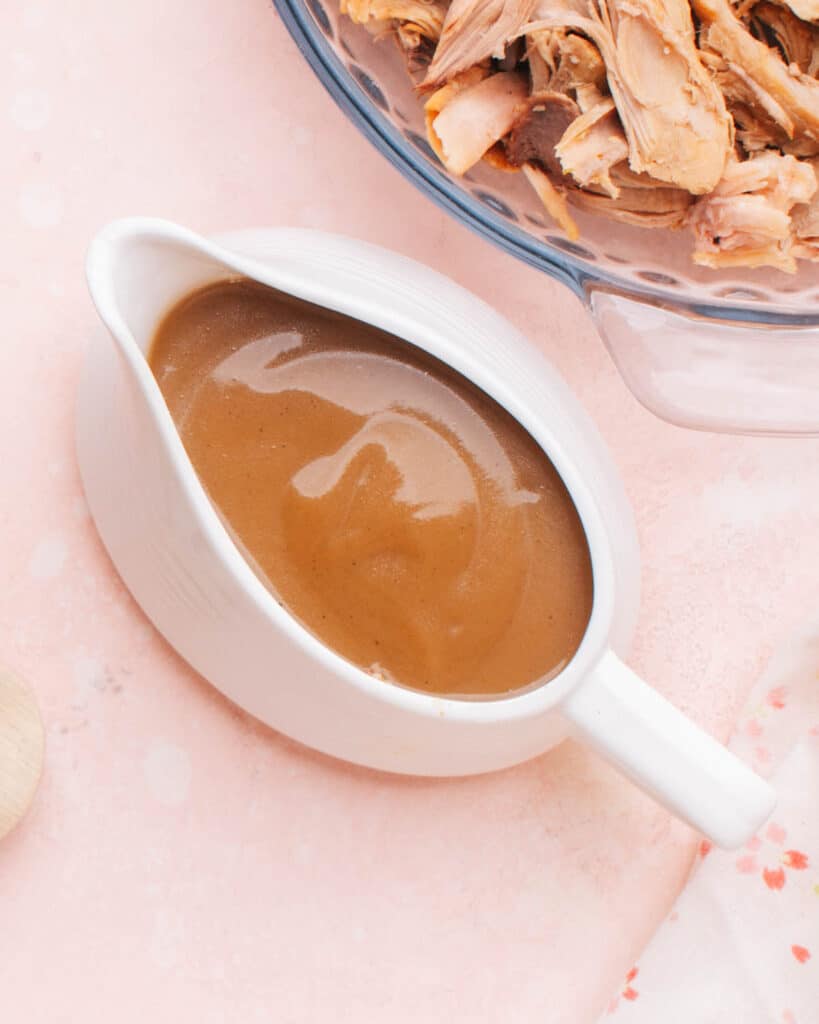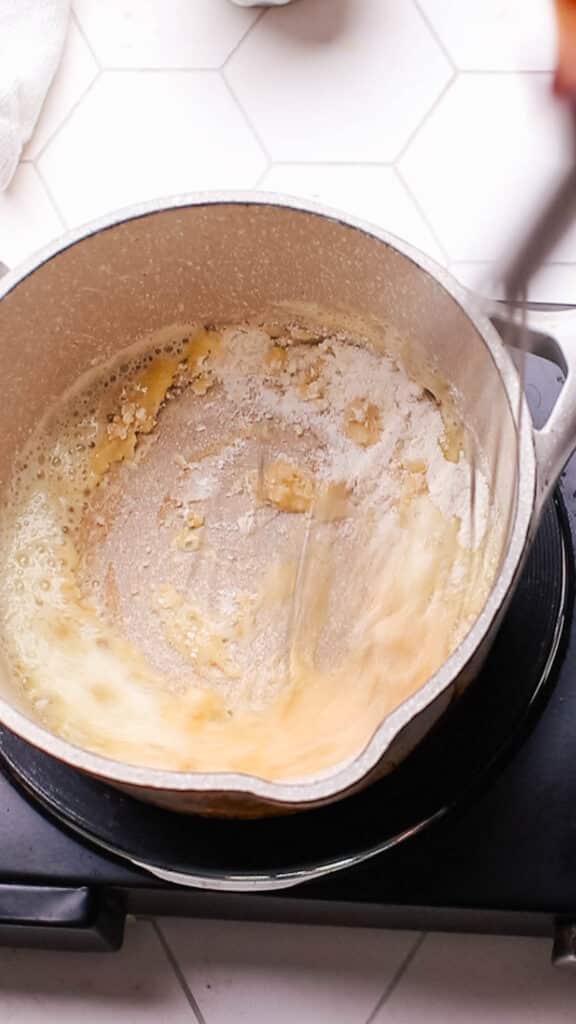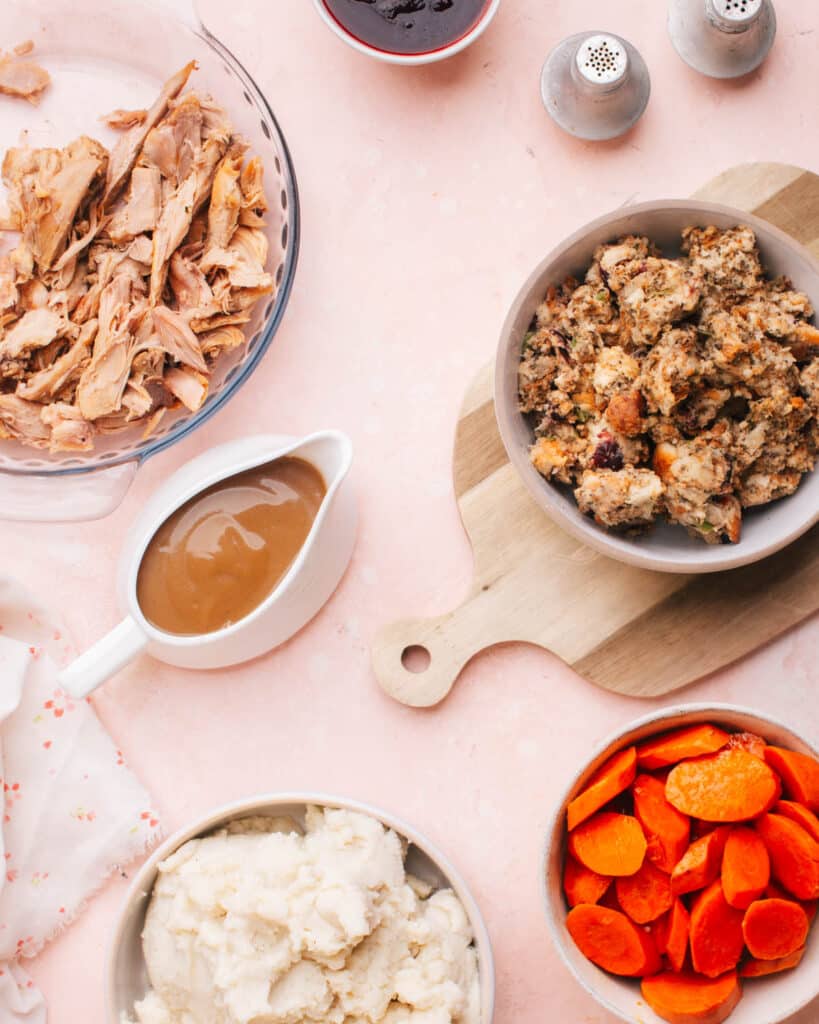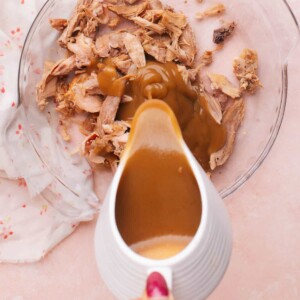Jan 20, 2024, Updated Mar 09, 2024
Why You’ll Love This Easy Turkey Giblet Recipe
I’ve got to admit, a roast turkey without a rich, savory gravy is just not complete. This turkey giblet gravy is rich, delicious, and made with simple pantry staples.
Is making a gravy for your turkey with pan drippings a pain? If so, this simple gravy is for you – it can be made while your turkey roasts with no need to wait for the turkey drippings! You can even make it a day ahead! It’s the perfect way to use the giblets and neck. I love a good, waste-free meal, don’t you? Simple, quick, and with no major skills required.
Here’s What You Need For This Thanksgiving Turkey Giblet Gravy Recipe
This is honestly such a quick and easy gravy recipe, especially if you make the broth ahead of time. I love that it can be made before my turkey is ready. Meal prep at its best.
Turkey Giblet Gravy Ingredients
You only need a handful of basics to make this yummy homemade turkey gravy.
Turkey giblets and neck: Some turkeys come with their giblets and neck tucked into their cavity, while others don’t. You’ll want to double-check this when you select your turkey. Onion, carrot, and celery: This trio provides the savory base. You can swap the onion or celery for leeks if necessary. Kosher salt: Essential for seasoning, kosher salt enhances the overall taste of the gravy. Black pepper: Freshly ground black pepper imparts a warm and pungent kick. Unsalted butter: Melted unsalted butter adds a luxurious richness and velvety texture to the gravy. All-purpose flour: Used to create a roux, the all-purpose flour acts as a thickening agent.
Variations and Substitutions
Here’s how to take this recipe in a couple of different directions. You can absolutely customize your turkey giblet gravy; keep that in mind.
Herby: Add a tablespoon of fresh or fried herbs. Think thyme, sage, or rosemary. Citrusy: Grated lemon or orange zest can balance your gravy. Spiced: Add in some cozy spices like whole nutmeg or cinnamon. Remember to fish them out at the end. Dijon mustard: Stir in a small amount of Dijon mustard for a grown-up touch.
Set Out These Tools
In preparation for your gravy, here’s what you’ll need to grab from the kitchen:
Saucepans: Just two regular small-medium saucepans will do. Fine-mesh sieve: This is to sieve the broth to separate out the whole parts. Whisk: To get that silky, lump-free gravy!
You’ll now be set to make the turkey gravy of your dreams. Let’s get started.
How to Make Turkey Gravy Without Drippings: An Easy Guide
This is a 3 part process that is just so simple. Here are the steps, broken down:
How to Make the Broth
Add the giblets, neck, water and vegetables (onion, carrot, celery) and salt into a saucepan. Simmer the ingredients together for 1-1.5 hours.
How to Make the Roux
In another saucepan, melt the butter on a medium heat. Once the butter has melted, add the flour and whisk the two ingredients until they have combined into a smooth roux. Cook them for about 5 minutes or until they are a deep caramel color. Remove the saucepan from the heat.
How to Combine the Broth and Roux
Strain the turkey stock through a fine-meshed saucepan into a bowl, cup, or jug. Add a little broth to the roux, whisking as you go. Once this is smooth, add a little more liquid and whisk again. Repeat until all the liquid has been added. Simmer until thickened, about 5-10 minutes.
A Few Notes
Keep an eye on your roux; don’t walk away from it, as it can burn easily. Make sure your roux is lump-free by adding liquid gradually while whisking constantly. When straining the broth, press the solids down to extract maximum liquid and flavor. Check the seasoning. If it needs more salt, add a little soy sauce. This adds a deeper color, more seasoning, and umami-richness.
Make Ahead and Storage
If you want to make this in advance and if you have a little extra, here’s what to do:
Make-ahead
There are a couple of steps you could take to save time:
Prepare the Broth in Advance: Simmer the turkey neck and giblets to create a broth a day or two before making the gravy. Roux: You can prepare the roux (butter and flour mixture) in advance, allowing it to cool, and store it in an airtight container in the refrigerator.
Storage
If you have extra gravy, here’s how to store it:
Refrigeration: Leftover gravy can be stored in an airtight container in the refrigerator for up to 3-4 days. Freezing: Allow it to cool completely before transferring to a freezer-safe container. Leave some space for expansion; it can be stored for 2-3 months.
5 Common Mistakes When Making Gravy for Turkey with Giblets
Here are the most frequent mix-ups to avoid when making turkey gravy with giblets without drippings:
Boiling instead of simmering the broth: This can lead to a cloudy broth that is lacking in veggie flavor. Lumpy roux: Whisk as you go! Burning the roux: Don’t walk away from it – this is the most common and easiest mistake to make. Adding all the broth at once: This is path that can only lead to a lumpy, bumpy gravy. Under-seasoning: Taste your gravy before you serve it. Add a little soy sauce if you feel it’s bland.
Final Notes, Pro Tips + Science-Based Secrets
Unlock the full potential of your turkey gravy with these key takeaways:
Go slowly with your roux: Be patient and allow it to become golden. This is how you’ll get a nutty flavor and eliminate the raw taste of the flour. Don’t under-simmer the broth: This will lead to a bland-tasting turkey gravy. Adjust the consistency: If the gravy is too thick, add small amounts of broth or water until it’s right. Balance the richness: If the gravy feels overly rich, add a splash of lemon juice or zest. Seasoning and umami-enhancement: Use a small amount of soy sauce or Worcestershire sauce to enhance the umami flavor of the turkey gravy.
Just skimming through? Here are some quick answers to the commonly-asked questions. What do I do if my turkey giblets include the liver, and I’m not a fan of its strong flavor? You can leave out the liver if you’re not a fan of it. Can I use chicken giblets instead of turkey giblets? Yes, you can substitute chicken giblets and make a chicken broth in your gravy-making if turkey giblets are unavailable. Keep in mind that the flavor profile may be slightly different. How can I make this gravy gluten-free? Substitute all-purpose flour with cornstarch for a gluten-free gravy. Can I freeze the gravy ahead of time? Yes, you can freeze the gravy for up to 2-3 months. Which herbs work well with this gravy? Herbs like thyme, rosemary, and sage complement the flavors of turkey giblet gravy. How can I fix a lumpy gravy? If lumps occur, use a whisk to stir the gravy vigorously. If the lumps persist, strain the gravy through a fine mesh sieve to achieve a smoother consistency. Can I make the gravy in advance and reheat it? Yes, you can make the gravy ahead. Reheat it gently over low heat, stirring continuously. Adjust the consistency with broth or water if needed. Is it necessary to strain the gravy? Straining is optional. If you prefer a smoother texture, strain the gravy to remove solid particles. If you enjoy a heartier gravy, you can skip this step. What can I substitute for unsalted butter in the recipe? You can use other fats like olive oil or clarified butter as a substitute for unsalted butter. Adjust quantities based on your taste preference.
What to Serve with Turkey Giblet Gravy
Easy Roast Turkey with Cranberry Chutney The Best Mashed Potatoes You’ll Ever Try Cornbread Casserole Apple Turkey Stuffing Candied Brussels Sprouts with Maple and Bacon Maple Five Spice Roasted Butternut Squash Super Easy Pumpkin Pie Green Bean Casserole with Crispy Onions Turkey Giblet Gravy Recipe (Without Drippings)
Next reading:
What to eat with leftover mashed potatoes Leftover Turkey Pot Pie Leftover Turkey Casserole Herbed Peppercorn Gravy
